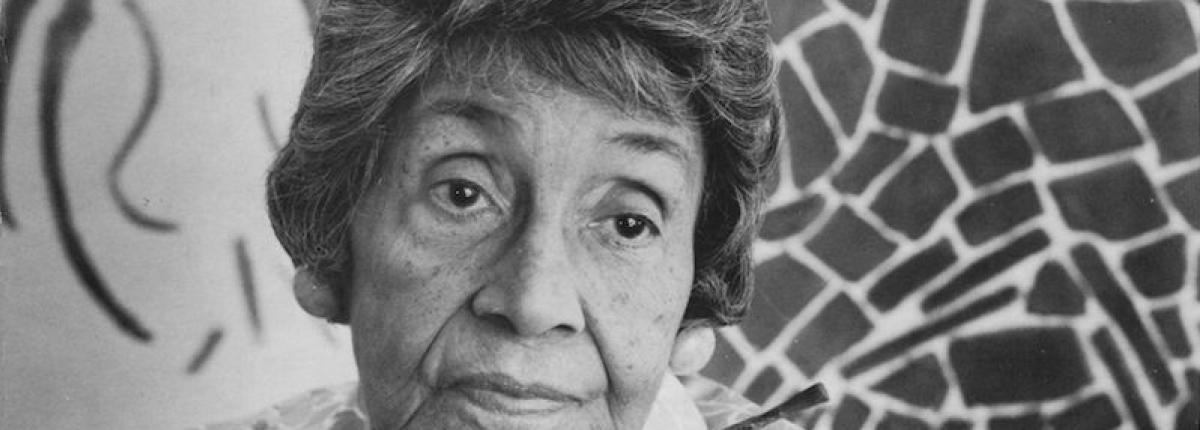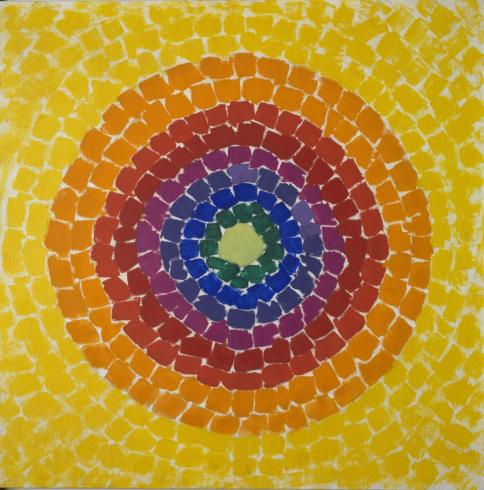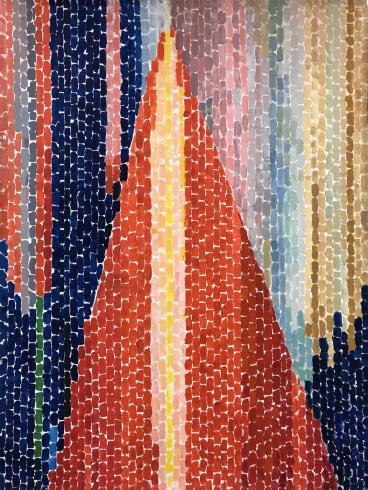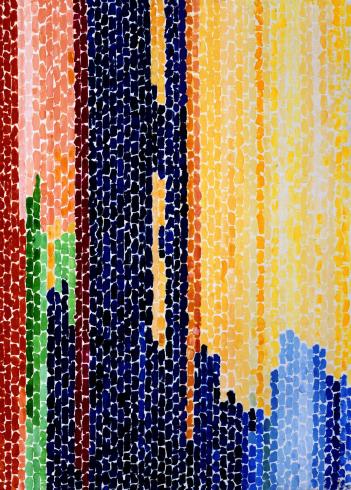The Artistic Process of Alma Thomas

Pre-Lesson: Space Exploration (Optional)
- Share with students that they will learn more about Alma Thomas, a Black artist and teacher from Washington, DC, who was inspired by nature and events happening in the world.
- During the time Thomas was alive, the world was involved in exploring space.
- Have students watch this video about Apollo 11.
- Ask students:
- Why do you think people were so excited about space exploration?
- What made this trip to space so special?
- Why do you think an artist would want to paint about space?
Part 1: Reflecting on the Art of Alma Thomas
Introduce:
- Share with students that they will learn about Alma Thomas, a Black artist and teacher from Washington, DC. Specifically, they will learn about her artistic process, or the way in which she created her art.
- Show students Alma Thomas’s painting Resurrection (page 1).
- In partners, ask students to jot down their responses to the questions on the Reflecting on Alma Thomas’s Art sheet.
- As a whole class, discuss answers to the questions.
- Share with students that they will continue to learn more about Alma Thomas’s process throughout this lesson.
Part 2: Understanding the Artistic Process of Alma Thomas
The Process:
- Watch this short video about Alma Thomas. (Note: video ends at 2 minutes 47 seconds).
- After watching the video, ask students what they noticed about the different Alma Thomas paintings featured in the video.
- Discuss with students some of the critical vocabulary that described Alma Thomas’s art and her process using the Alma Thomas Vocabulary guide. Words included are:
- Abstract
- Pattern
- Rhythm
- Mosaic
- Vertical
- SYNTHESIZE: In pairs, have students complete the Art Detective Worksheet to synthesize their understanding of the vocabulary.
A Deeper Dive:
- Explain to students Alma Thomas’s process for creating her paintings:
- Watercolor sketch: When Thomas had an idea, she thought through the idea using watercolor.
- Sometimes, she tore paper and taped and stapled the torn paper to canvas to test out different color combinations. You can see an example and close ups of the details here.
- Pencil sketch: Once she had her idea mapped out, she would sketch out her idea in pencil on canvas.
- Final painting: Then, Thomas used acrylic to paint.
- Fun fact: Art experts have used x-rays to study paintings. From x-rays of Thomas’s work, we learned that sometimes she would write the letter for the color she planned to use in the spaces she sketched out. Sometimes she changed her mind about what color to use because x-rays show the letter no longer matches the color in the final painting.
- Show students the watercolor study of Launch Pad (page 2) and the final version of Launch Pad (page 3) to show the differences between and progression of a study to the final painting. Can they spot the differences in any colors or shapes that Thomas decided to change in the final artwork?
- Fun fact: Art experts have used x-rays to study paintings. From x-rays of Thomas’s work, we learned that sometimes she would write the letter for the color she planned to use in the spaces she sketched out. Sometimes she changed her mind about what color to use because x-rays show the letter no longer matches the color in the final painting.
- Watercolor sketch: When Thomas had an idea, she thought through the idea using watercolor.
Part 3: Paint Like Alma Thomas
- Take students step-by-step through Alma Thomas’s process. Like Thomas, they will first create a watercolor study and then do their final artwork in acrylic paint.
- Select the subject: Pick something from nature. This can be a rainbow, a flower, the sun, trees— anything they’d like!
- Sketch: Using a pencil, sketch out the object from nature on watercolor paper.
- Create the mosaic: Draw equally spaced boxes in the object. Students can choose if they would also like to fill up their background with boxes or keep it a solid color.
- Teacher note: You could have them do this free-hand or with a ruler and measure their boxes (for either the study and/or the final painting).
- Option: Students can rip up colored paper and tape it to their sketch. Allow them to move colors around as Thomas would have done.
- Express with color: After sketching and creating the boxes, pick the colors that best represent the object you picked from nature. Paint in watercolor, mapping out what colors they want to use in their final painting.
- Note: Like Thomas’s study, the watercolor paints will bleed together and make the boxes less defined. In the final acrylic painting, the paint will bleed together less and allow for more defined mosaic-like boxes.
- Sketch the boxes: Using the watercolor study as a guide, take a new piece of paper and sketch out the final piece. This time, only sketch the boxes; do not sketch the outside outline of the object. In each box, write the first letter of the color you’ll use in that box.
- Get painting! Once students have created their roadmaps, they should use acrylic paint to create their final piece.
Reflect:
- Have students reflect on their experience creating art based on Alma Thomas’s artistic process. They can share out or write down their reflections.
- Describe your painting using at least two of the vocabulary words learned:
- Abstract
- Pattern
- Rhythm
- Mosaic
- Vertical
- What was easy for you?
- What was challenging?
- What did you most enjoy about this process?
- Describe your painting using at least two of the vocabulary words learned:
Additional Context
Lesson Context
Alma Thomas was a Black artist and teacher from Washington, DC. Thomas was a part of the Washington Color School, a 1950s-1970s art movement in response to Abstract Expressionism; the artists used bold colors to form simple, flat shapes, stripes, and fields of color, rather than focusing on emotion, gesture, and movement. Thomas differed from many other Washington Color School artists, whose works did not reference any objects from real life; instead, her works combined the bold colors and shapes from the Washington Color School with the emotion and dynamism of the Abstract Expressionists.
Thomas was inspired by what she saw in the natural world, current events, space, and space exploration. Space was of particular interest for Thomas because of its relevance during the late 1950s through the 1970s. During this time, the world saw humans go to space for the first time. In 1969, three U.S. astronauts, Neil Armstrong, Buzz Aldrin, and Michael Collins, were chosen by NASA to head into space on Apollo 11. Armstrong became the first human to step on the moon.
To capture the wonder, energy, and excitement that she witnessed in the world, Thomas developed a unique artistic process that involved vibrant colors as well as abstract and repeated shapes to depict the beauty in what she observed. She often sketched in pencil and watercolor and used that as a guide before creating her final pieces on canvas with acrylic paint.
Key Terms
Abstract: A style of art that does not look realistic.
Concentric circles: Circles that ripple out and share the same center.
Mosaic: Pattern or image made of small pieces of materials, such as colored stone or glass.
Pattern: Shapes, lines, or colors that repeat.
Rhythm: The movement of a piece of art. Movement can be created by how the artist uses lines and patterns.
Vertical: Lines that go up and down (or top to bottom).
Washington Color School: a 1950s-1970s art movement in response to Abstract Expressionism; the artists used bold colors to form simple, flat shapes, stripes, and fields of color, rather than focusing on emotion, gesture, and movement.
Watercolor: Paint that is thinned with water, giving the artwork a more transparent color.


